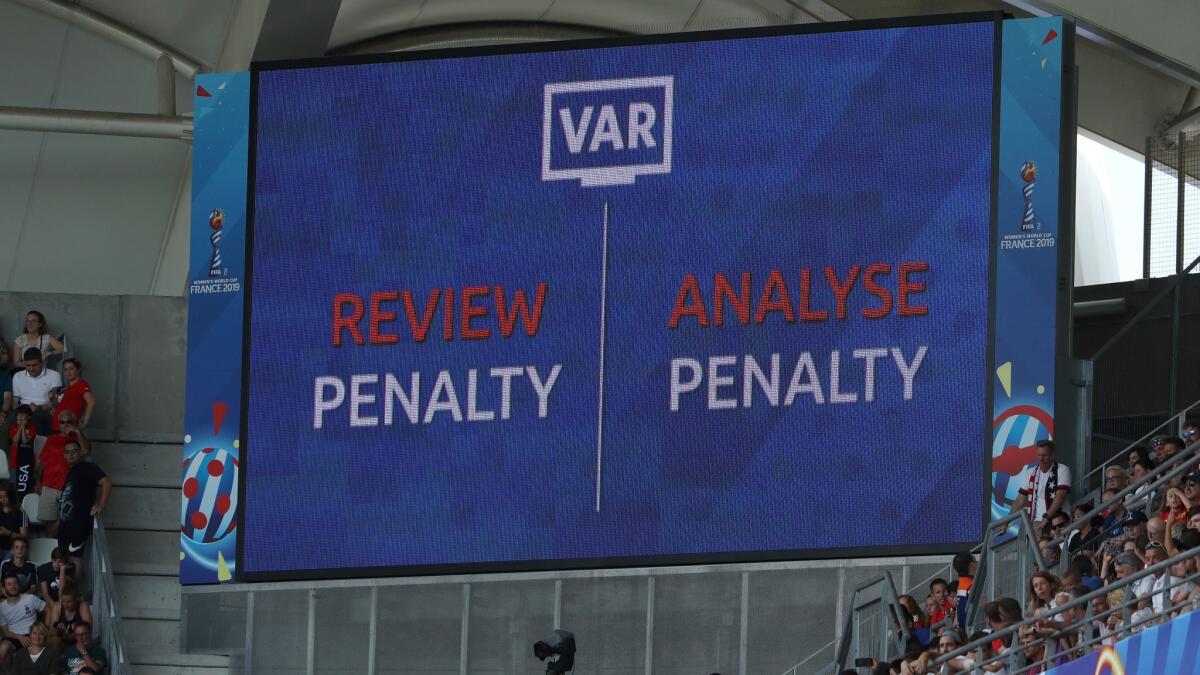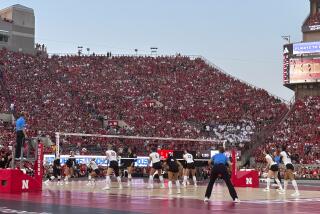25 of 29 World Cup video reviews have overturned calls on the field

- Share via
Reporting from paris — The rarely seen mascot of this Women’s World Cup is a French poussin named ettie, although it really ought to be a referee hunched over a TV screen watching a video replay.
VAR, or the video assistant referee, is making its Women’s World Cup debut in France, and through the first 44 games, there have been 29 VAR reviews. That’s four more than in the entire 64-game men’s World Cup last summer.
Twenty-five of the 29 calls reviewed were overturned, meaning the ruling on the field was reversed. And Pierluigi Collina, widely considered to be the best referee of all time and now chair of the FIFA referees committee, said that’s progress.
“I’m happy to have something that can help the referee,” he said. “And I would have been happy to have had the same when I was refereeing when I committed a mistake.
“Making a mistake at the World Cup means to have the World Cup over. If you have something that can save you, that offers you a second chance, no one cares if a wrong decision is corrected by the VAR. It’s something that helps everybody. It’s just a matter of getting used to it.”
But VAR, which made its World Cup debut in the men’s tournament last summer in Russia, hasn’t been universally embraced. England coach Phil Neville urged FIFA to have a long look at VAR after the group stage of the women’s tournament was marred by several controversial decisions, such as the handball call that led to a goal that eliminated Japan in the round of 16.
Many of the reviews stretched on, stopping games at dramatic junctures and interrupting the flow of play. Hungarian referee Katalin Kulcsar, for example, needed four minutes and a reported 12 different camera angles to confirm the penalty call that decided the U.S. game with Spain.
“It has taken an inordinate amount of time over decisions that are incredibly marginal,” New Zealand coach Tom Sermanni said. “I think it’s made some very poor decisions.”
Collina pushed back on that too.
“It’s matter of time versus accuracy,” he said. “You cannot be accurate and be fast. This doesn’t mean we are happy to be slow.
“We are trying to do things very quickly, but sometimes you need to check more things.”
Continental divide
For the first time, seven of the eight quarterfinalists in the Women’s World Cup are from the same confederation, in this case UEFA. And United States forward Tobin Heath, who played two years in France with Paris Saint-Germain, isn’t sure that’s a good thing.
“As a football fan, to me, I would want a little bit more diversity at this point. I find European football sometimes a little boring. And there are some teams that are so exciting to watch, that you won’t be able to see this kind of different style,” she said, naming Brazil and Japan as two examples.
“Which is unfortunate at this stage because I really appreciate certain teams that are no longer in the tournament.”
Record ratings
The Brazil-France round-of-16 game Sunday was seen by more than 47 million viewers in the two countries, with Globo TV’s audience of 30.6 million breaking the record for a Women’s World Cup match set four years ago by Fox, which drew 25.4 million for the U.S.-Japan final in Canada.
Another 4.7 million watched on other Brazilian outlets.
The TV audience on TF1 in France was 10.6 million, with another 1.36 million watching on pay outlet Canal+.
S’il vous plaît ?
With the U.S. preparing to face France in a quarterfinal match Friday, Heath — and everyone else present — was surprised by a question from a television reporter Wednesday at the U.S. team hotel on the edge of Paris.
“I’m French so I have just one question,” began the reporter. “Can you please let France win?”
“That’s a question?” Heath replied. “No.”
Sign up for our weekly soccer newsletter »
kevin.baxter@latimes.com | Twitter: @kbaxter11
More to Read
Go beyond the scoreboard
Get the latest on L.A.'s teams in the daily Sports Report newsletter.
You may occasionally receive promotional content from the Los Angeles Times.








